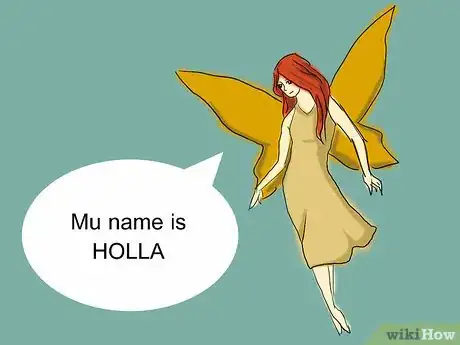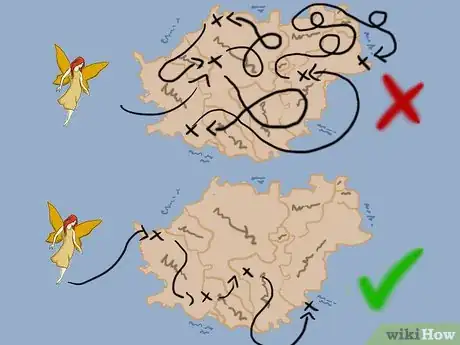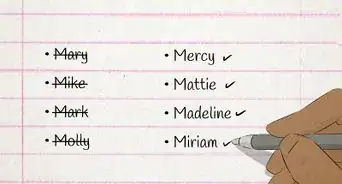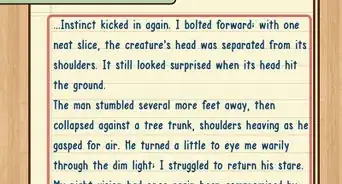X
wikiHow is a “wiki,” similar to Wikipedia, which means that many of our articles are co-written by multiple authors. To create this article, 26 people, some anonymous, worked to edit and improve it over time.
This article has been viewed 124,710 times.
Learn more...
Ever wanted to create your own mythology for a fictional text, or simply for fun? Here is a simple guide to the best, most believable way of creating a belief system or myth of your own.
Steps
-
1Decide where you want your myth to be set.[1] Location is the best place to start. If your myth is set on a different planet or place, try reading about real cultures and ways of life in areas similar to where you want your myth to be set. Write down three main locations, and what life around those places might be like.
-
2Start to create your characters. Most myths contain Gods and Goddesses, so try to read around other Gods and Goddesses you are interested in. Use traits or parts of their myths to build your own. For example, Thor, the Viking God of War and Lightning, had a hammer he used to create thunder. Your God/ess could have a similar instrument for creating a problem in your story. Most myths answer a question, such as 'Why does it rain?' or 'How did the world begin?'. Be inventive and stick to your cultural or historical setting.Advertisement
-
3Understand the conventions of myths in the culture you are created;[2] most are passed down orally 'by speech' and this means they have features of speech, such as repetition 'Fee, Fi, Fo Fum...' or the rule of three; 'three fairies' or 'three boxes'. Use this within your own myth to create the structure. Don't worry if it isn't perfect, or is totally different, there are always exclusions to the rule.
-
4Come up with appropriate names.[3] Naming your characters and settings can be done earlier, but unless it is vital to your story, don't feel blocked if you can't work them out immediately. Try to make the names fit with the culture you are creating; a neolithic war god called 'Trevor' may not be the best name to keep the readers engaged with the story. Try to make them pronounceable if possible, especially if it will be read aloud. Look at local names or languages to the area you are trying to imitate.
-
5Don't make it overly complicated, at least initially. Many stories are very simple and short, and can be formed in about a paragraph. However, others may be longer, such as the Saga Beowulf.[4] If your work is longer, try to plan it using the previous steps as much as possible, so it can meet it's final ending.
-
6End your story with a solution to the question or problem,[5] such as 'And that is how The God (BLANK) Created Rain.' If your story/myth ends sadly, such as with the death of the main character, such as in Oedipus, remember to include a reason for their death. Everything that happens in a myth is always relevant to the story, as they are usually spoken with little room for much else. You will need to include a message or moral about fate, greed or something to do with human nature, as this is a very common factor in most myths. Good luck!
Advertisement
Community Q&A
-
QuestionHow do I create a mythical god?
 Community AnswerYou could base them off someone you know or pull characteristics from multiple friends. Gods also have special powers. You could think of an element or a part of life that you like or a power you wish you had. Finally, this God needs a name. You could choose something that connects to one of the characteristics or their power.
Community AnswerYou could base them off someone you know or pull characteristics from multiple friends. Gods also have special powers. You could think of an element or a part of life that you like or a power you wish you had. Finally, this God needs a name. You could choose something that connects to one of the characteristics or their power. -
QuestionHow do I conclude an interesting myth?
 Community AnswerYou can kill off the character (sad ending), have everyone solve all their problems (happy end), or simply leave the reader with a moral/ esson and leave it at that (neutral end).
Community AnswerYou can kill off the character (sad ending), have everyone solve all their problems (happy end), or simply leave the reader with a moral/ esson and leave it at that (neutral end). -
QuestionHow do I introduce a myth?
 Community AnswerStart with a problem - as big or as small as you want to make it. Then figure out how your characters (gods, mortals, or whatever you're working with) will solve that problem.
Community AnswerStart with a problem - as big or as small as you want to make it. Then figure out how your characters (gods, mortals, or whatever you're working with) will solve that problem.
Advertisement
Warnings
- Try not to be offensive by using Gods and cultures with a limited understanding of them. Existing myths and beliefs mean a lot to the people who follow them and using existing figures, especially as negative figures, can be considered highly insulting. Just because you might not believe in these factions of belief doesn't mean we have the right to be offensive. Always try to be as respectful as possible, even if you are challenging parts of a culture.⧼thumbs_response⧽
Advertisement
References
- ↑ https://writefortheking.wordpress.com/2015/07/13/world-building-creating-history-legends-and-myths/
- ↑ https://www.writersstore.com/how-the-great-myths-and-legends-were-created/
- ↑ https://www.fantasynamegenerators.com/god-names.php
- ↑ https://writersedit.com/fiction-writing/the-ultimate-guide-to-world-building-how-to-write-fantasy-sci-fi-and-real-life-worlds/
- ↑ https://tvtropes.org/pmwiki/pmwiki.php/SoYouWantTo/CreateAMythopoeia
About This Article
Advertisement
































































